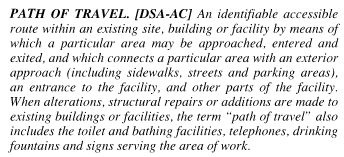Mr. Inspector
SAWHORSE
Did an inspection the other day on a building that is undergoing alterations affecting an area containing a primary function which the code then requires an accessible route to it. The route between the building and the accessible parking space had many cracks and uneven surfaces. I told them thy need to repair this. But the code does not require an accessible parking space when doing alterations only a route from one if there is an existing accessible parking space.
The accessible parking space only had a short accessible parking sign, no linage or access aisle and too much of a slope to comply as an accessible parking space.
This made me think later that if the accessible parking space does not comply 100% to the code is it really an accessible parking space and can I require an accessible route from it to the building?
No definition of an accessible parking space in the ICC A117.1 but definition of accessible describes a site, building, facility or portion thereof that complies with this standard. Since the space does not comply to this standard it can't be considered an accessible parking space?
The accessible parking space only had a short accessible parking sign, no linage or access aisle and too much of a slope to comply as an accessible parking space.
This made me think later that if the accessible parking space does not comply 100% to the code is it really an accessible parking space and can I require an accessible route from it to the building?
No definition of an accessible parking space in the ICC A117.1 but definition of accessible describes a site, building, facility or portion thereof that complies with this standard. Since the space does not comply to this standard it can't be considered an accessible parking space?

